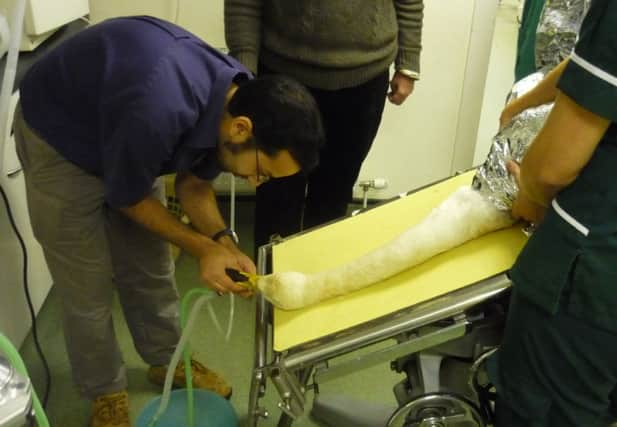Community rallies to rescue protected bird at death’s door


The magnificent bird – a winter visitor to these shores from Iceland - was struck down by lead poisoning after arriving at the Lower Derwent Valley National Nature Reserve.
It was later discovered that the bird had swallowed several pieces of lead shot after visiting ponds just outside the reserve, which are used for shooting.
Advertisement
Hide AdAdvertisement
Hide AdThe case highlights the risks posed to birds and animals when they venture beyond the nature reserve’s perimeters, although Natural England, which manages the site, is working closely with the owners of adjacent land to tackle the problem.
Reserve employees were carrying out checks at Aughton Ings near Bubwith on New Year’s Day when they spotted the swan sitting on the ground looking unwell.
When they approached the bird, it managed to fly off briefly but crash-landed a short distance away.
The team recognised the tell-tale signs of poisoning and quickly delivered the swan to Jean Thorpe, who runs Ryedale Wildlife Rehabilitation from her home at Norton near Malton.
Advertisement
Hide AdAdvertisement
Hide AdJean, who was awarded the MBE in the New Year’s Honours List for her work with sick and injured wildlife, rushed the swan to the Battle Flatts Veterinary Clinic at Stamford Bridge, where vet Mark Naguib gave it an x-ray.
The x-ray showed there were a dozen lead shots in the bird’s gizzard, a muscular pouch behind the stomach that’s used for grinding food. The birds digest small stones and grit to allow this process to happen, which is how lead shot is picked up.
Three dead swans were found in the local area shortly after the sick bird was discovered and rescued. X-rays carried out on one of the bodies showed more than 40 lead shots in the bird’s gizzard, a quantity that would have killed it fairly quickly. The grim discovery confirmed that the swans were picking up lead shot from a source close to the reserve and staff traced the problem to some nearby ponds.
Senior reserve manager Craig Ralston explained: “It’s important to stress that nothing illegal has happened; it is perfectly legal to use lead shot outside of the reserve. “We realised that the swans had been visiting ponds on nearby farmland that are baited with grain for the purpose of shooting ducks.
Advertisement
Hide AdAdvertisement
Hide Ad“When ponds are used for shooting over a period of many years, lead shot builds up in the water and because the ponds are quite small it is very concentrated.”
Mark said that, in such situations, Natural England can work with landowners to try to tackle the problem: “One option is for people to switch from lead shot to steel, but there is no legal obligation for people who shoot to do this. It’s a case of trying to persuade them.
“Another alternative is for us to offer to help people clean their ponds carefully, which is a specialist job as it involves de-silting them to remove any lead that may be trapped in the silt at the bottom.
“This case demonstrates that we can’t just manage wildlife within the boundaries of the reserve itself. Thankfully, we have a good relationship with landowners around here, who are very proud of what we’ve got in the Lower Derwent Valley.
Advertisement
Hide AdAdvertisement
Hide Ad“Places like this probably wouldn’t exist if it wasn’t for the historical protection afforded to them because of their value as farmland and places to harvest ducks.”
The sick swan had its gizzard flushed out under anaesthetic and was given fibrogel to help any remaining shot to pass through its gut. It was also given medication to treat the symptoms of lead poisoning.
When it was well enough to start eating again, tests confirmed that the bird’s kidney function had returned to normal, which meant that it had suffered no long-term damage as a result of the lead poisoning.
Jean Thorpe said: “The swan was very ill when he was found and Mark Naguib worked hard to get him right.
Advertisement
Hide AdAdvertisement
Hide Ad“He had to have two gizzard flushes and medication before he began to respond to treatment.”
After a week of rest and recuperation in Jean’s care, the swan was ready to be released back onto the nature reserve, where it rejoined the rest of the flock of Whooper Swans wintering there.
Jean continued: “These beautiful birds come here from Iceland during the autumn and stay on the flood plains in the Lower Derwent Valley for the winter.
“It was an absolute joy to see him released back onto the reserve by Craig Ralston, who originally picked him.”
Advertisement
Hide AdAdvertisement
Hide AdCraig added: “This is a great example of lots of people with different skills all working together to produce a successful outcome for our local wildlife.
“The dedication, skill and efforts of Jean, Mark and our NNR staff have resulted in not only a single Whooper Swan being returned to the wild after facing almost certain death, but also a potential deadly threat to our internationally important wildfowl populations being identified and addressed.”
The rescuer also known as Badger Jean
In the past four decades Jean Thorpe has saved countless wild animals, including her beloved badgers.
Known locally as Badger Jean, her passion was sparked when a lapwing with a broken wing was brought to her home as a child - her parents were both birdwatchers. She dug up worms to feed it until frosty weather came, making the ground hard and her mother called Flamingo Land, who decided to take it on.